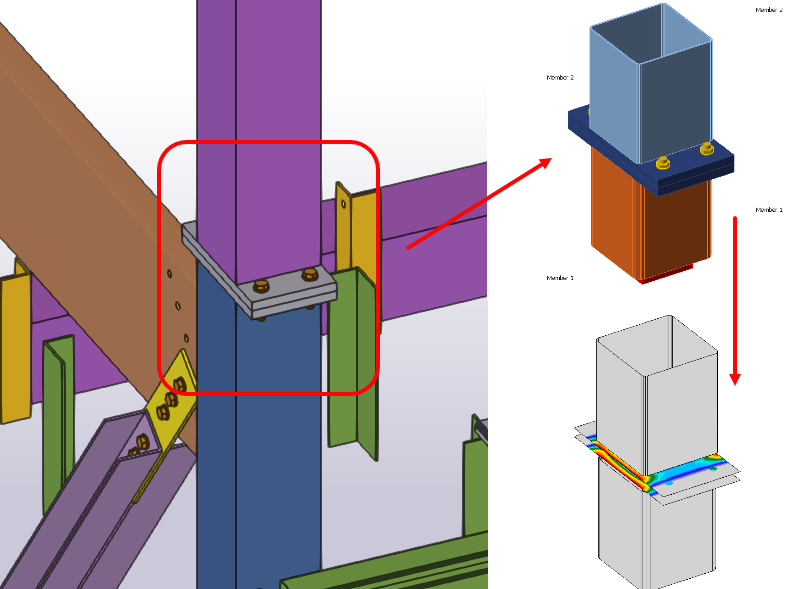BIM – The answer to all our (structural engineering) prayers?
Building Information Modeling (BIM) has been with us for over a decade and yet it is still, more often than we would like, seen as a hurdle to efficient working. There are several reasons behind this observation but mostly it is because I have listened to and seen how lots of engineers work and how they cooperate with others.
Over ten years ago, I proposed that there were three types of modeling:
- Modeling for documentation
- Modeling for analysis and design
- Modeling for construction
The first of these, many proponents of Structural BIM are comfortable with and many will agree that it has streamlined their business.
However, despite the vast resources of the main vendors, not many are integrating the geometrical model with an analytical model. There are huge benefits to be had if this is utilized.
The third level is when the structural model is developed further so that it reflects not only WHAT is going to build, but HOW it will be built. There are even fewer engineers that make it this far and those that do are usually working very closely with the main contractor.
For this article, I am going to focus on the second stage as I am sure the first one has been covered time and time again. The third stage will be a topic for another day but suffice to say that the evolution of the model is a linear one and information should not be lost but augmented and developed.
What approach should engineers follow?
There are many approaches to integrating the structural analytical model with the geometric. Generally, the approaches fall into three categories: direct, file-based and middleware.
An example of both the direct and file-based approach is Autodesk Revit which has an analytical and geometrical model combined. Tekla Structures integrates via file transfer. The new kid on the block is from the Nemetschek Group with a cloud-based middleware solution - SCIA AutoConverter - which has introduced a new file format (SAF) based on Microsoft Excel.
All have their merits, pitfalls and drawbacks. Whichever route is chosen it is imperative that the workflow is understood, or the approach will rapidly become ‘shelfware’.
Again, I have seen this many times!
If connection design is to become part of the overall BIM process effectively then it should be flexible enough to fit into any approach. The company I work for – IDEA StatiCa – has a solution that code checks steel connections (amongst other solutions) using a technology called Checkbot.
Checkbot satisfies the requirements when modeling for analysis, design AND construction. The technology has been designed to be flexible with the potential to merge workflows in the future.
Connection design requirements
Connection design engineers are an offshoot of the structural design process without which though the steel frame would not stand up. Where is connection design considered in the workflow? Usually towards the end of the design. What piece of steel hits a foundation first? A baseplate connection.
In the past, connection designers have relied upon the engineer providing them with the information they needed via marked-up drawings. More often than not the transmitted forces bore no resemblance to the load cases and combinations used to code-check the actual members.
I will hold my hand up and say I was one of those. I had thought the days of using the maximum moment with the maximum shear and maximum axial (all rounded up to the nearest 25kN/kNm) had gone. But sadly they have not.
Connection designers require the same combination results as well to ensure that the connection stands up to ALL the possibilities, not a perceived worst case. However, it is obvious that documenting every load case combination result for every member in a connection is fraught with danger: there is an additional risk that the figures (and sign) could be wrong.
Some solutions can output to a spreadsheet such as Microsoft Excel but even this approach will lead to some data preparation to get the data in the right format.
Our approach
At IDEA StatiCa, we have developed a series of BIM Links (using Checkbot) that connects our connection design solution with an eco-system of FEA and BIM (CAD) solutions. Some of our partners have also developed links from their FEA and BIM solutions to IDEA StatiCa using our IOM (IDEA Open Model).
This methodology allows the sharing of information and decreases the risk of error with a huge increase in efficiency. For an engineer, model sharing is so much more than just a geometrical model.
But if an analysis model is to be shared it too must be correct and computable.
What do I mean by computable?
First, it must assemble correctly with no ‘floating’ nodes. Members must connect to the right nodes. It can be a simplified model (engineers like things to be simplified) with several members meeting at a designated node when in fact they do not. The members should be in the correct plane and not skewed because the alignment assumptions are wrong. There should also be an equilibrium of forces which should ideally be obtained directly from analysis results.
But what happens if we have both the geometrical model and the analysis model (possibly from different engineers)? There is a hybrid approach that we can leverage whereby we can create two projects in IDEA StatiCa using the geometry from one and the analysis results from another. This is the merged model approach. It does, however, require both parties to have synchronized models with the correct members in the correct locations.
Summing up
What are the rules that engineers should obey for effective information use?
- Consistent models for the whole workflow – members placed correctly in all models
- Computable models – an analysis must be possible
- Materials should match the region and be consistent in all models
- Section sizes should ideally be consistent in all models
- Avoid using special or compound sections or document them
- Work together
The information that IDEA StatiCa creates forms the basis for stage 3 – Modeling for construction as it feeds into the fabrication process, but it uses information developed from stages 1 and 2 to push the design onwards.
I am not saying that the whole of the industry is like this. We like to think that we are ahead of the curve and not afraid to try things new. But honestly, I still hear the same response to challenges surrounding existing workflows: "because that’s the way we have always done it…"
There is so much more we can do as an industry to avoid wasted time and materials, or reduce the carbon footprint of a design.
And as engineers, we can lead the way. These are not new ideas.





